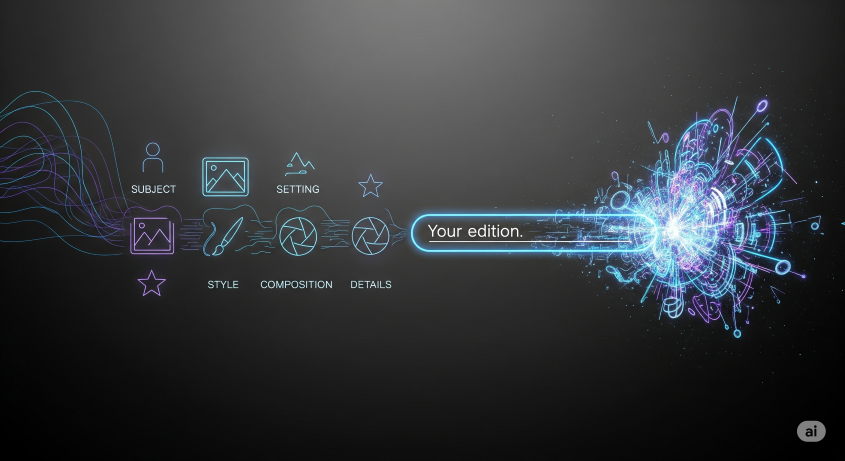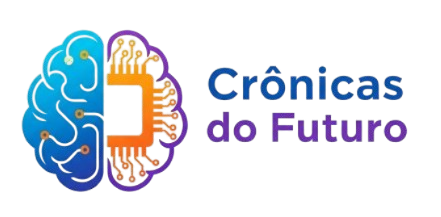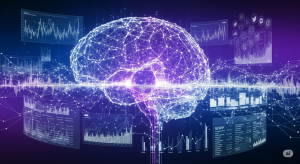
Have you ever had a brilliant idea for an image, typed the description into an Artificial Intelligence tool, and… the result was disappointing? A character with three arms, a lifeless scene, or something that simply didn’t capture the magic of your imagination. If this has happened to you, know that it’s neither your fault nor the AI’s. The secret lies in the “recipe” you give it.
That recipe is the prompt. And the difference between a generic image and a digital masterpiece lies in how you construct this instruction.
Forget the idea that creating prompts is a gift for tech geniuses. In reality, it’s a skill anyone can learn. In this comprehensive guide, we will break down the anatomy of a good prompt, revealing the 5 secret ingredients that will transform how you communicate with AI and help you create incredible images consistently.
What is a Prompt (and Why is it Everything)?
Before we get to the ingredients, let’s align on the concept. An image prompt is not just an order; it’s the start of a conversation. It’s the set of instructions, descriptions, and commands you give to an AI (like Midjourney, Leonardo.ai, or DALL-E) so it can translate your vision into an image.
A weak prompt is vague. A good prompt is a detailed script.
The 5 Secret Ingredients for Creating Incredible Images
Think of your perfect prompt as a gourmet dish. Each ingredient has a specific function, and their harmonious combination is what creates the magic.
### 1. The Subject (The “What?” of your Image)
This is the main element, the actor in your scene. The golden rule here is specificity.
- Simple Prompt:
a robot - Detailed Prompt:
an old humanoid robot, made of brass and copper, with glowing blue eyes
The more details you provide about the appearance, material, color, and characteristics of your subject, the more faithful the result will be to your imagination.
### 2. The Action and Setting (The “Where?” and “Doing What?”)
A static subject is boring. Bring your creation to life by placing it in a context. What is the subject doing and where is the scene taking place?
- Simple Prompt:
a robot in a library - Detailed Prompt:
an old humanoid robot, made of brass, sitting in a leather armchair in a Victorian library, reading an old, dusty book
### 3. The Artistic Style (The “Soul” of the Image)
This is, perhaps, the most powerful ingredient. This is where you define the visual “vibe,” the filter, the lens through which the AI will create your image. The possibilities are endless.
- For a realistic look:
cinematic photography, 85mm lens, soft lighting - For a blog/corporate look:
flat vector illustration, minimalist design, solid colors - For a fantasy look:
concept art, digital painting, epic, matte painting - For a classic look:
oil painting, Rembrandt style - For a futuristic look:
cyberpunk aesthetic, neon lights
Tip: Tools like Leonardo.ai already offer pre-trained “models” that make it easier to choose a consistent style.
### 4. Composition and Lighting (The “Cinematography”)
Here, you become the director of the scene, controlling the camera and lights to create the desired atmosphere.
- Composition:
close-up shot,medium full shot,top-down view,wide-angle shot - Lighting:
dramatic lighting,golden hour, sun rays,soft, ethereal glow,high contrast
### 5. Magic Details (The “Finishing Touch”)
These are the technical terms that elevate the quality of your image from “good” to “stunning.”
- Render Engine: Adding terms like
Octane renderorUnreal Engine 5can give a hyper-realistic 3D finish. - Quality: Words like
4K,8K,hyperdetailed,intricateforce the AI to generate more details. - Artist References: Mentioning an artist (e.g.,
in the style of Greg Rutkowski) can guide the AI toward a specific aesthetic (always check if the platform allows this).
Putting It All Together: A Practical Example
Let’s create an image for a post about “AI in the future of cities.”
| Ingredient | Simple Prompt | Detailed Prompt (using the 5 ingredients) |
| Subject | a futuristic city | a futuristic city with organic, flowing architecture |
| Setting | with flying cars | with autonomous flying cars and lush vertical gardens |
| Style | drawing | concept art, digital matte painting |
| Composition | panoramic view, wide-angle shot | |
| Lighting | golden hour lighting, with soft mist | |
| Details | hyperdetailed, 8K |
Exportar para as Planilhas
The final prompt would be: “A futuristic city with organic, flowing architecture, autonomous flying cars, and lush vertical gardens, concept art, digital matte painting, panoramic view, wide-angle shot, golden hour lighting with soft mist, hyperdetailed, 8K”. The result will be infinitely superior.
Conclusion: You Are the Artist, AI is Your Brush
Creating incredible images with AI is not about knowing secret codes, but about learning to communicate with clarity and creativity. The 5 ingredients — Subject, Setting, Style, Composition, and Details — are the foundation that will allow you to translate any idea into a digital work of art.
Now you have the recipe. The next step is to start experimenting, mixing ingredients, and discovering your own style. The future of visual creation is collaborative, and your imagination is the only limit.
Frequently Asked Questions (FAQ)
Do I need to know English to create good prompts? While many AIs understand other languages, English still has the richest vocabulary for styles and technical terms. Using a translator like Google Translate or Deepl for specific terms can greatly improve your results.
Where can I find inspiration for styles and prompts? Platforms like Leonardo.ai and Lexica.art are excellent. They function like a “Google for AI images” and, most importantly, they show the exact prompt that was used to create each image.
What’s the most incredible image you’ve ever created with AI? Share a prompt tip in the comments! And don’t forget to subscribe to Crônicas do Futuro for more guides like this one.

